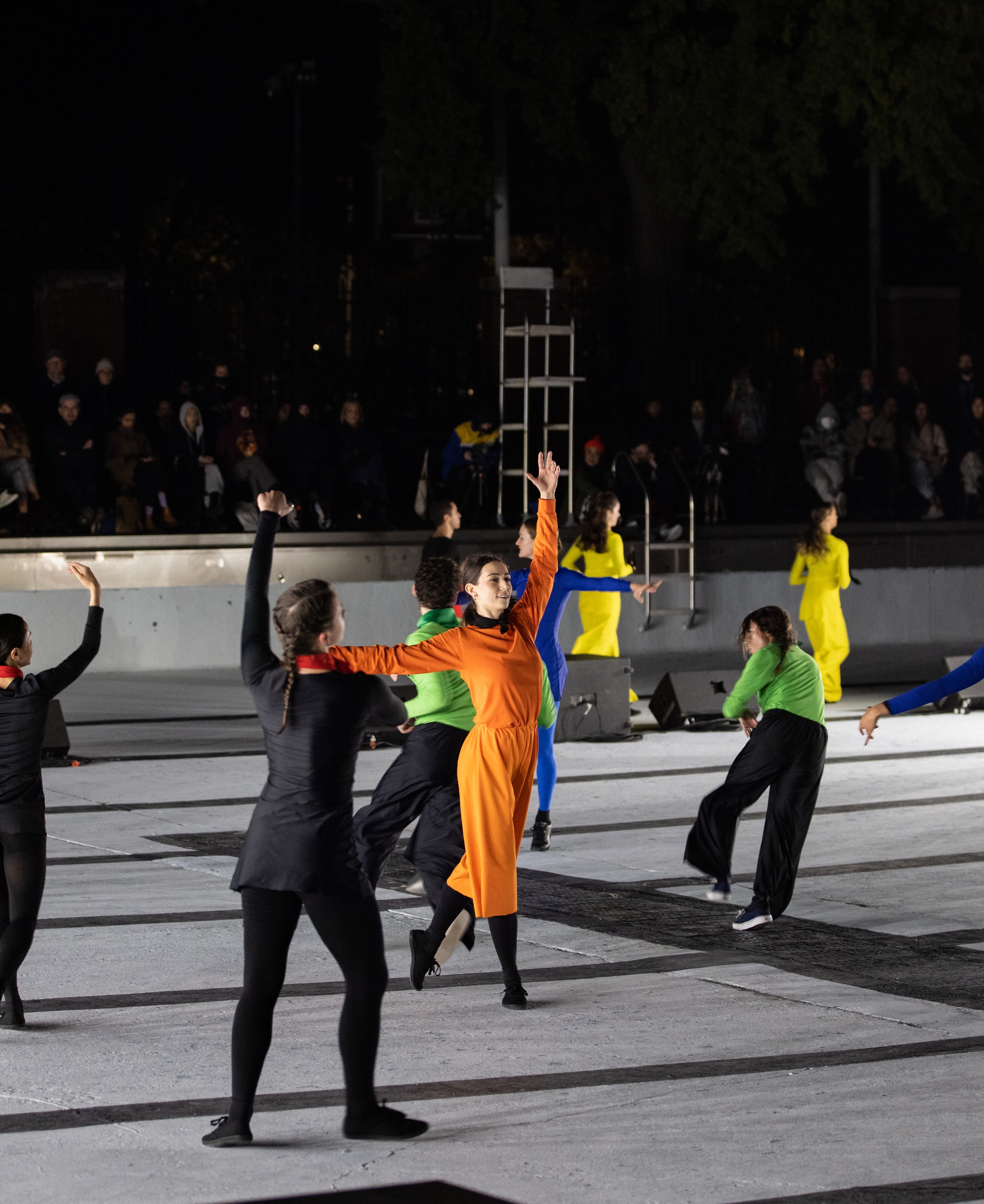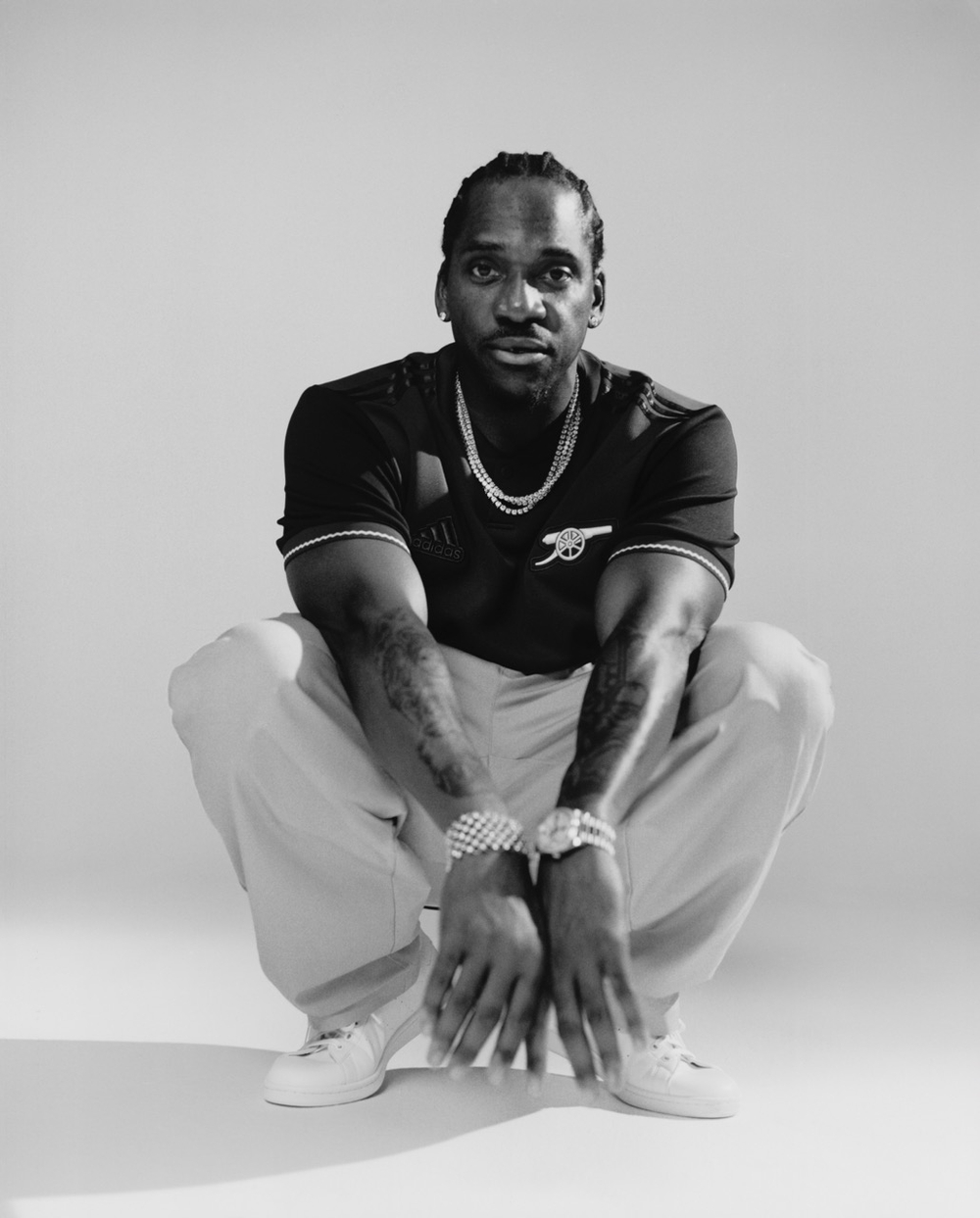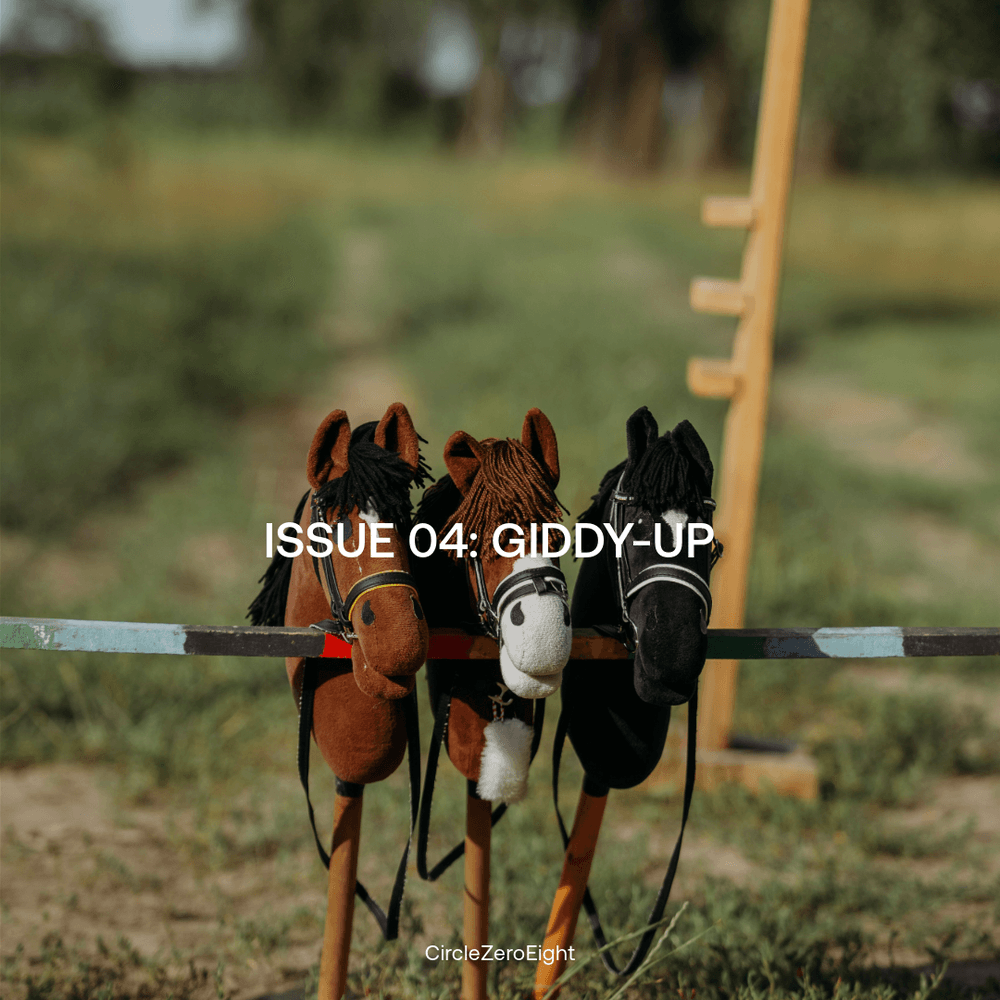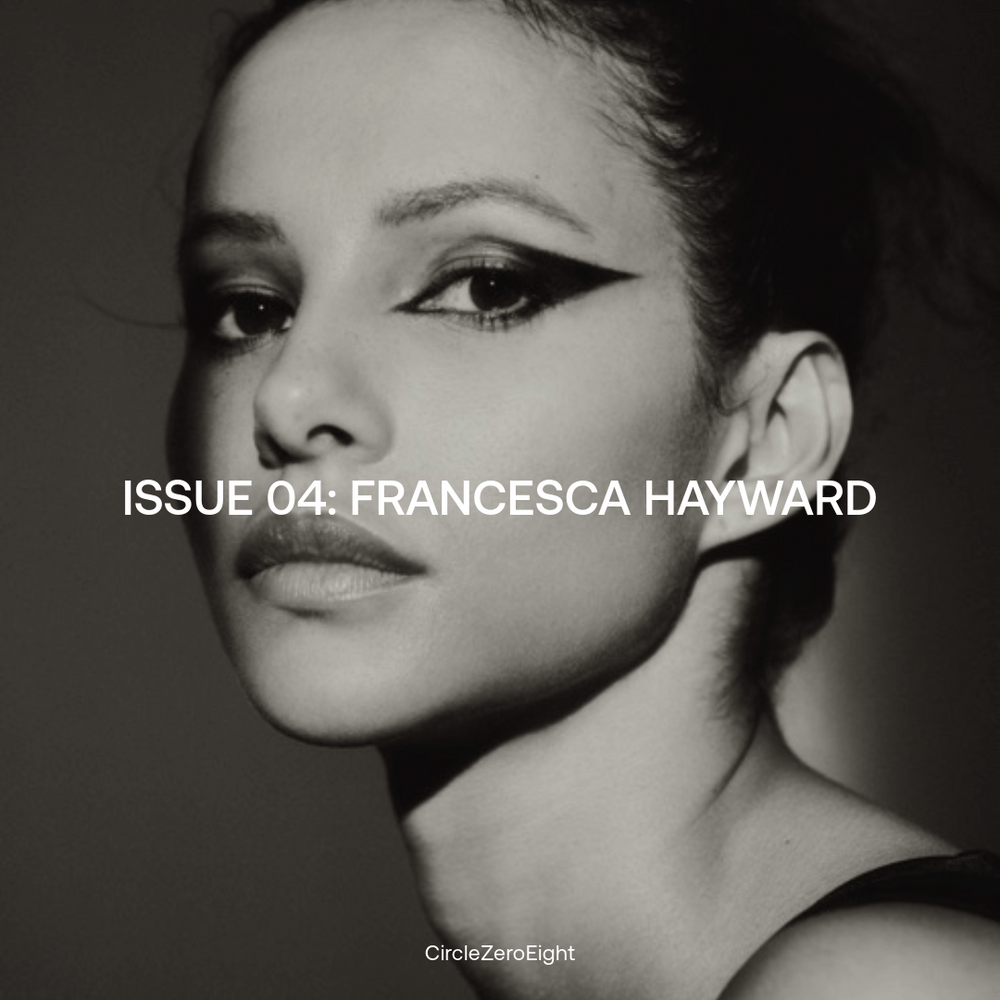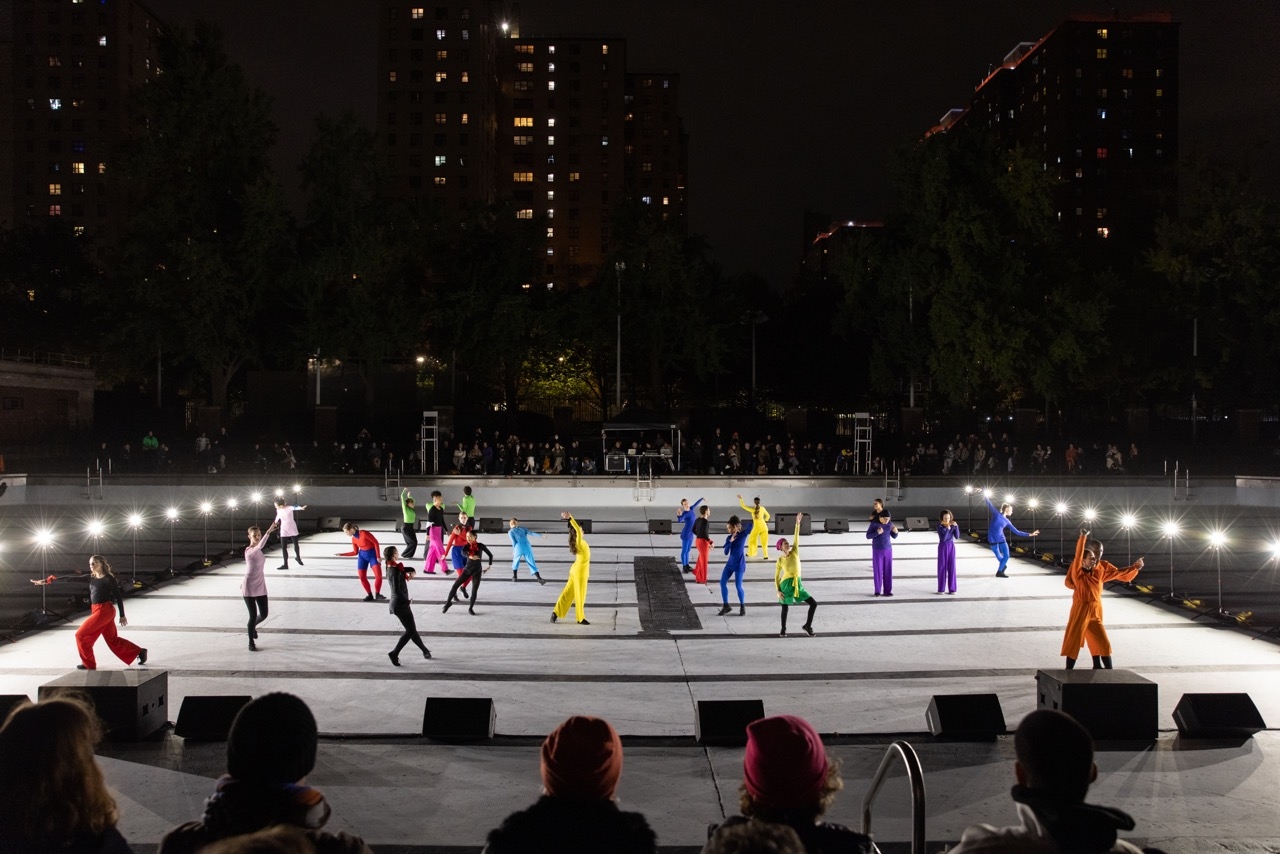
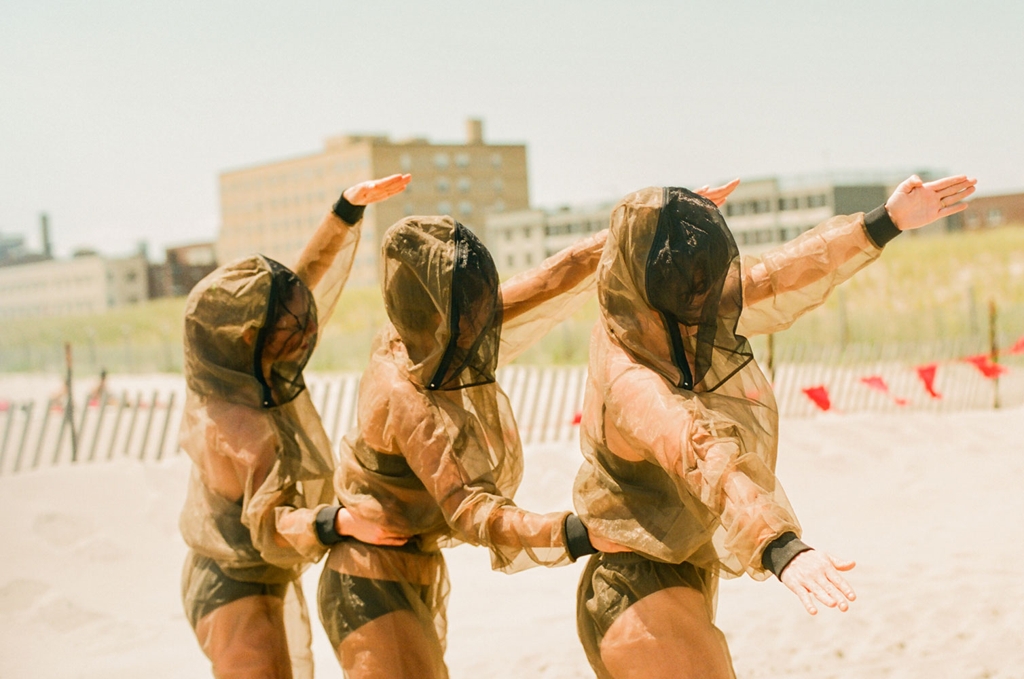
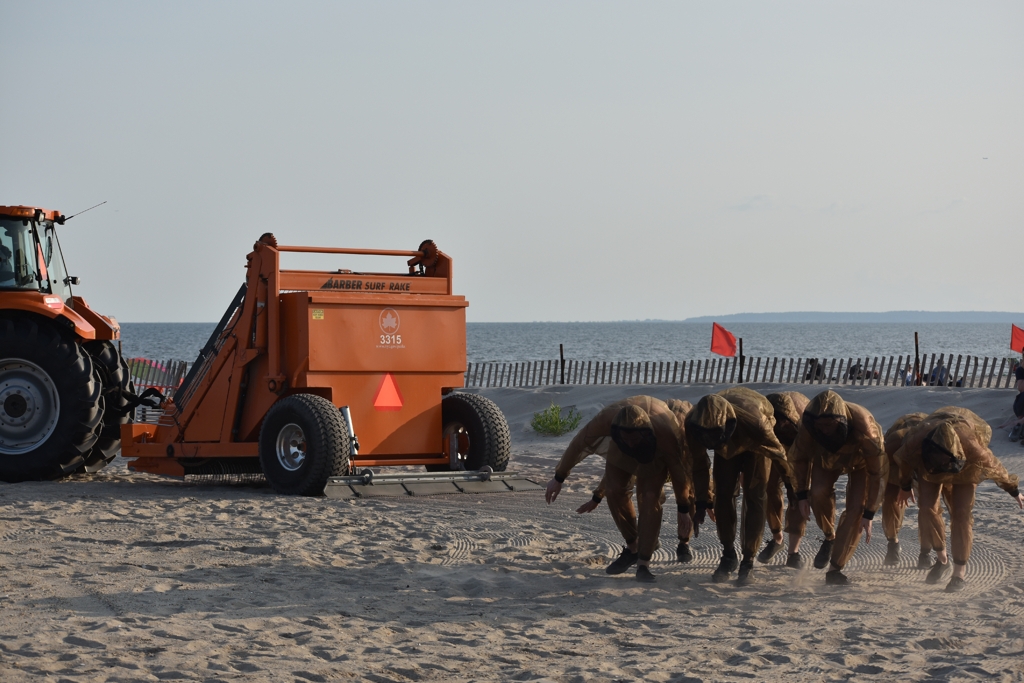
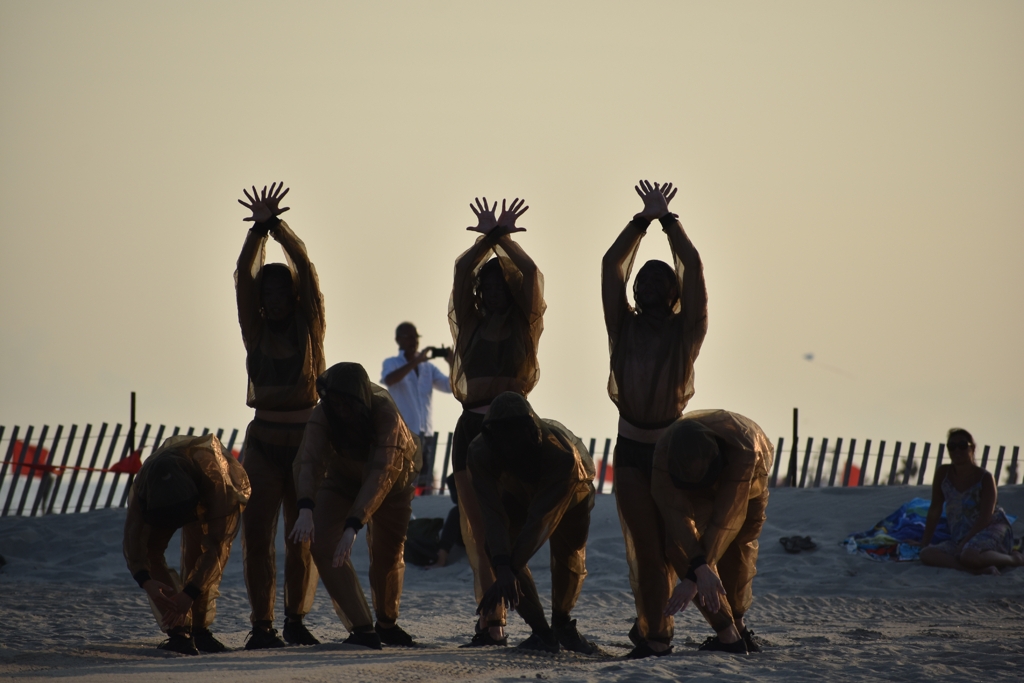

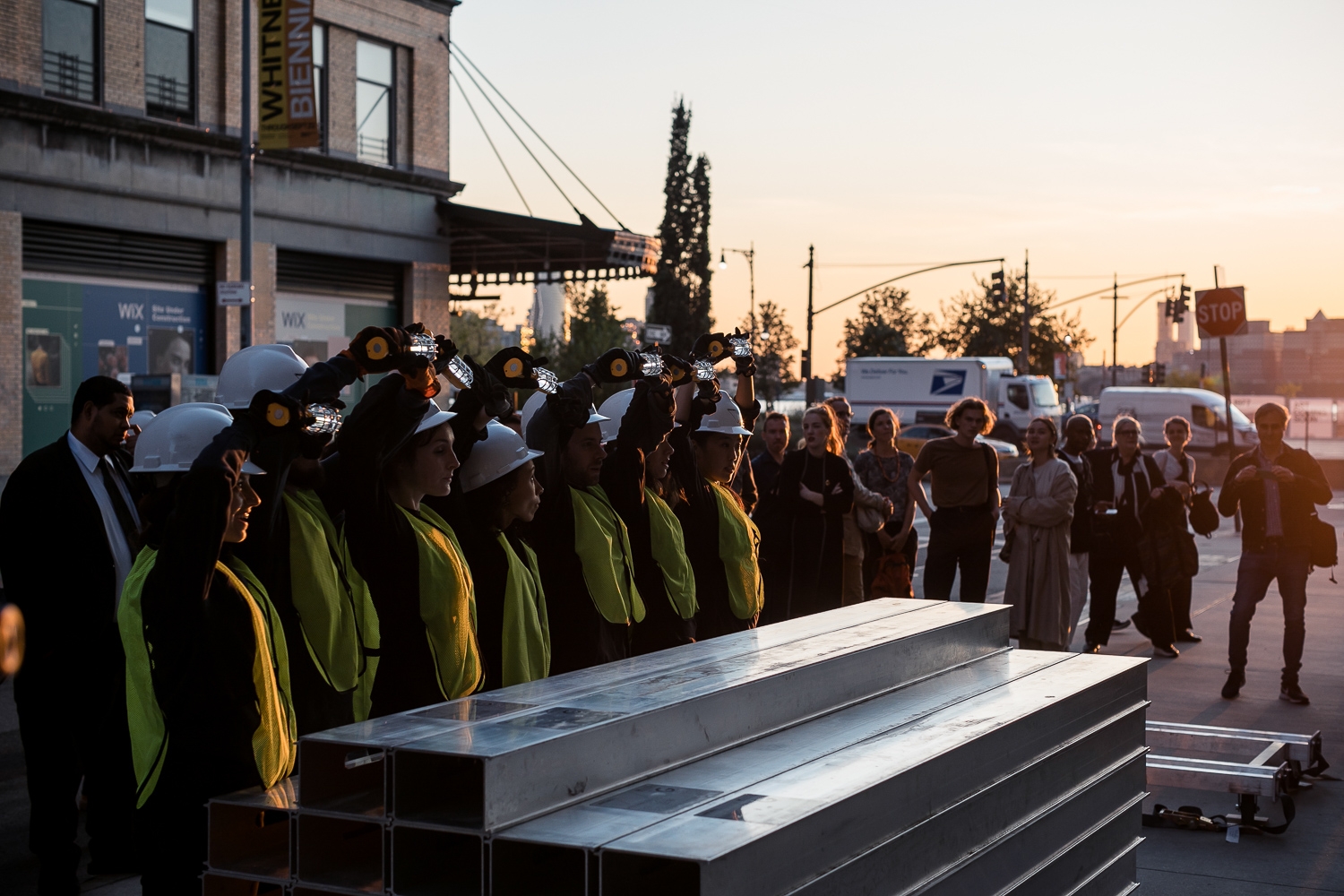

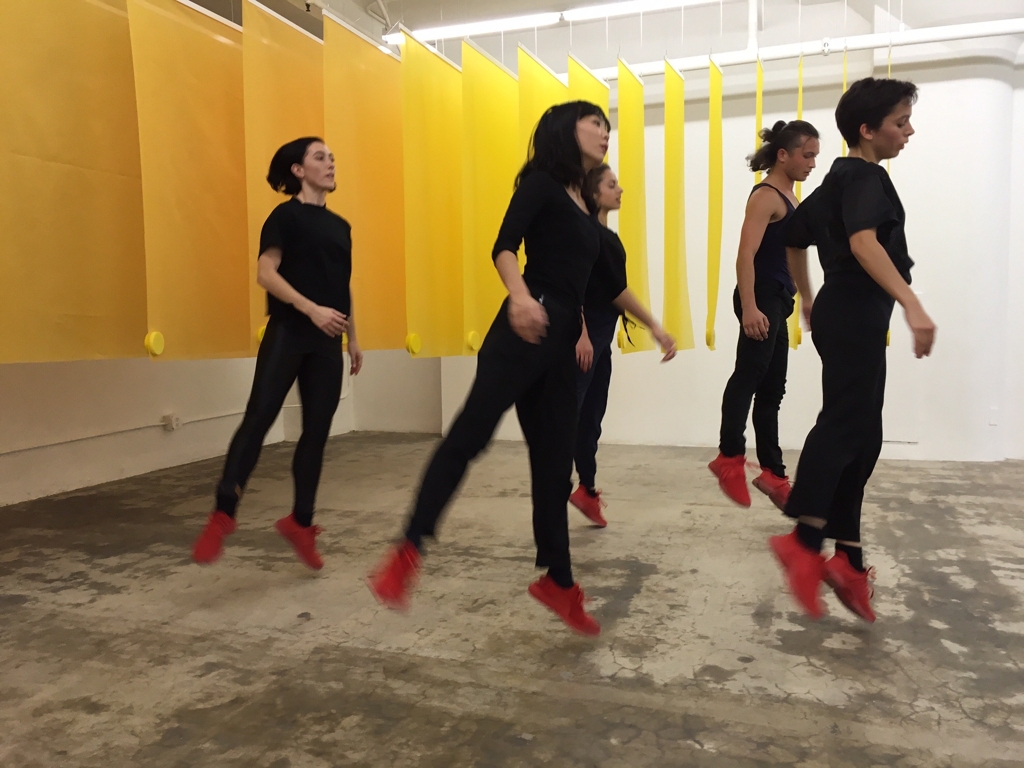


With an exhibition currently showing at Jeffrey Deitch Gallery in Los Angeles, a baby and a ballet in Paris, artist Madeline Hollander speaks with Rob Diament about movement, performance and the dance of sport.
RD: What are you working on at the moment?
MH: Sunrise/Sunset just went up at Jeffrey Deitch Gallery [in Los Angeles]. So that just happened. And then I’m preparing for a show at the Metropolitan Museum in New York next spring and I’m working on another film as a choreographic consultant, and a ballet!
RD: I’ve been thinking a lot about the way that you work and when I see you described in biographies, it always says artist and choreographer. And it got me thinking about the seriousness of this term, choreographer, because I think with your work, it’s like the choreography part is such a science, in a sense. How do you balance art and choreography? Because I do feel like they are quite distinct.
MH: That’s so interesting that you brought that up, because I actually only think of myself as a choreographer in the sense that I’m an artist who works with movement as the medium. But that seems to be more confusing to the art world than just saying I’m an artist. And then people are like, oh, but you do choreography. And so those two codes are just to help clarify, because it’s less common to have an artist whose primary medium is movement that isn’t based in any object or any material form, even though it manifests in material form, it’s just always movement. Whether or not it’s headlights or chairs or dancers or cement mixing trucks or sleight of hand magicians or ballet dancers, it’s always movement. And then the title of choreographer is also not perfect because I’m not just choreographing movements. I’m usually pulling ready-made movements and ready-made choreographies and things that are already existing from our everyday lives and protocols and systems and kind of sculpting. The act of piecing those together into a framework is so that an audience can approach that and understand it that way. So I think that ‘artist’ is probably the correct title, and then in parentheses, instead of painter, it’s movement.
RD: I’ve always thought of you as an artist, but the way you think is so different to other artists I know. And that’s why I find your work so rewarding and so endlessly fascinating. The way your mind works is very different to a lot of artists, I think, because you’ve got this precision and focus and analytical approach to things. And it’s almost like the discipline and the rigour of having been a dancer in the past and thinking about choreography means your approach to art-making is so rigorous and so strong. In a way, I just love the clarity of it. It is like every dance movement has a purpose and a way to express a feeling or will take you to another place, even if it is within that particular routine. I feel like there’s such precision to the way you make art.
MH: Yeah, I think the rigour is definitely embedded in there because of my ballet training, probably most of all. But then that goes hand in hand with the rigour of the research or what rabbit hole that takes me down. I feel like some of that precision isn’t for the sake of precision. But it’s for the sake of having to hyperarticulate if you’re working with movement, because you can’t always understand the meaning, the concept or the message behind these processes and how it appears; so it’s going to be a little bit more cryptic when it’s based in the language of movement. And so to really make sure that every single gesture, nuance, form, material, how they’re connected, why they’re connected, is based on a narrative that has its origins in the site and the people who are handling the material and whatever the concept is, I think it needs the rigour, out of necessity for it to be translatable to an extent.
RD: Tell me a bit about how you utilised this analytical approach in “Review” [2021]. One thing I found the most fascinating was your selection of dancers, and the fact that they didn’t come from one genre.
MH: Yeah, there are about 20 different New York based companies that were participating in that and several dancers from each. And the project actually started during the beginning of Covid 19. It was almost the opposite of itself, where I had planned to do a piece called “Preview”. I was going to work all summer with dancers from these 20 different companies and I wanted to kind of generate this feeling of what’s about to come and show this glimpse into this intense rehearsal period. And I was working with people who are working towards premieres in the fall. All these different shows and performances. I wanted to put them all on stage doing this kind of cryptic movement. Which is called marking. It’s like a version of performing the piece through your body, usually through your arms and hands and upper body more than your legs. In order to kind of process the sequences in your brain without exerting too much energy, it’s something you do over and over again in rehearsal before you go full out. And that’s when you really give it your all. I have been fascinated by this marking language; as a ballet dancer there’s a really complex grammar to the movement. It’s incredibly articulate and something where I can travel anywhere in the world and take a ballet class without speaking a language just because I can watch the instructor do these movements and know exactly what’s going on. So jumping ahead, that piece was in the midst of beginning rehearsals and getting the whole production together, and then all of a sudden, the pandemic hit, so all of the productions that I thought were going to open that fall were no longer. They were shut down indefinitely. And at first it was like, let’s push it back, and then the pushing back ended up just becoming a joke. And I continued this relationship with these dancers that I had started to speak to about all this and all of a sudden it became clear that they had been working so hard on these choreographies and really stressing over them, and a lot of them were premieres for them. It was the first time they would be on a Broadway stage. It’s a huge deal for their careers. But it was stuck inside them [because of the pandemic]. And so that’s when I decided that it would be appropriate to just remove the “P” from “preview” and turn it into a piece called “Review”. Being in the pandemic I thought it would be more meaningful and more timely and appropriate to kind of gather a group of some of them, to have them actually perform the pieces that were never performed on stage, to put them all together on the stage where they would go through the three different iterations of the piece.
So in the first, they’re all kind of standing there, they’re barely walking around and they’re doing the whole piece from the beginning to end using the marking language. The second time they go through the piece, they’re doing it with their blocking as well. So they’re kind of blocking their position on the stage. They’re using their hands and their upper body, so there’s a lot more movement, but they’re still not exerting energy. And then the third version is kind of like the almost full-out marking version where you’re not going to do anything that might injure yourself, but you’re going to just go through it, warm your body up, really kind of do the thing that you do. Like the moment the curtain goes up to get yourself kind of revved up for the performance. So it’s still holding back. It’s still like they’re in their tennis shoes. They’re not in point shoes, they’re not in costume. It was still not the final version, but at least you get the full energy of what that character or role would embody. And so the biggest puzzle was all of a sudden I have 50 something dancers on a stage and they’re all performing their pieces that take up a whole stage. There were a lot of collisions and it was really distracting for them because they’re all in their heads trying to hum their music and go through their piece. But then I quickly realised that by letting them practise and get used to who’s close by, the other person is doing the same thing. They just started to kind of naturally find these beautiful ways of manoeuvring around each other. And so it became a lot of slight adjustments and some timing things.
RD: It got me thinking a lot about Kinesthetic tactile learning, which is obviously a phrase I didn’t really know until I was analysing your work. But Kinesthetic is something where a bit like riding a bike or using a swing as a kid, you can pick up how to do something through the actual action and doing it, and it really got me thinking about my own childhood, because I used to dance and I wanted to be a ballet dancer. So for the whole of my childhood, all I did was dance. But I began to see the world through choreography and through movement. And I wanted to express myself very strongly through performing for almost every single person that came through my parents’ door, at the house, at school, anywhere, I would dance and perform. But it got me when I used to go out and walk around. Your work has reminded me that I literally used to sit there and look at the world as if it was choreography, as if they were all dancing. I’ve hardly ever seen football, I’ve only been to a few football matches in my life, but when I went to see a match in Fulham, England, I watched this match between two different teams, and I remember thinking how the football team were just like dancers and how the kits they wear were kind of like costumes. And the audience, it was just like a massive operatic, Roman-style kind of amphitheatre. And it was a world that was hyper-masculine, but I really saw it all as choreography. Is that something that happens with you? Is that how you see the world?
MH: Absolutely. I’ve always thought of ballet as this operatic performance, especially with the lights, music, costumes and all the rituals of how the performers begin and end; the fact that it’s highly choreographed, especially. It’s all a dance, it’s all technique. Like if I went to a bullfight in Madrid, it’s so closely related to the rhythms of ballet and flamenco and these postures. But I feel like one thing that I’ve noticed since being a kid is that I see this in sports for sure, but then I also look up in the sky and there’s aeroplanes and helicopters, and I’m like, oh, the air traffic control tower. They are the choreographers of this whole dance that’s going on above our head. Watching traffic and seeing cars, that feels equal to a dance or the way that something is bending in the wind, just like really anything that was moving, I started to choreograph in my head.
I’ve always wanted to do a ballet or a piece that is dance, and set it in a sports arena. I’m really interested in the type of viewership that you get in sports arenas versus something that you see on the stage. I’ve gone to so many performances that were these durational performances, and watched so many people just leave or just come in and not watch. And then I go into a sports bar and I see people just, like, staring at the screens, or going to a sports game, people are just there till the very end, and they’re so involved in the performance. And I wanted to see what would happen if I made a dance that was actually a race. So it would be something where the audience could take bets and you would have to see which dancer came out first. So the piece is called “Miles”. It was a set choreography that looped. And there were seven dancers, and they had to go around the space three times because that was exactly one mile. As we performed it more times, people started to catch on that this was happening, that a different dancer was hitting the finish mark each day. And then people started to gather and watch as intently as they were watching a sports event and doing things like placing bets on the dancers. And so the dancers were not actually racing each other. They’re just trying to execute the choreography as best as they could on sand in the heat, as exhausted as they were. So it was really about how do you get to the end as opposed to getting there faster.
RD: I know that you’ve made a lot of work outdoors, so out in the world, not necessarily on a traditional stage, like the things you did in the Socrates sculpture park and you’ve done other installations.
MH: I think that’s one of the reasons that I’m always drawn to doing things in public because I want these performances to be encountered by a pedestrian who is not expecting to see anything or something where someone could walk by and not know whether or not it’s a construction site. It’s a ballet performance. To have no idea what’s going on and to see that there is a type of rhythm and choreography happening and to stop and wonder or even talk to someone about what’s happening. So I decided to do my whole piece for the Biennial outside the Whitney [“Ouroboros: Gs”, 2019].
RD: Yeah. That was the construction steel sections, wasn’t it?
MH: Yes, the flood mitigation system. That is a really beautiful kind of structure that goes around, circumnavigates the museum and is something that they keep out of sight because the museum is very, very close to the Hudson River. It turned into a bathtub during Hurricane Sandy. And so they developed this very elaborate flood mitigation system that when they do a drill, it happens at four in the morning, when no one can see it. But it’s a beautiful system that I feel like everyone should see! We should see how it works and the significance behind it, and the fact that doing a drill once a year is not good enough. This is going to become what was once that 100-year storm and is now happening every five years, potentially every year eventually. Who knows what’s going to happen? But these phenomena that are happening more and more frequently need to be put into our daily rhythms. As opposed to something that is a crisis emergency protocol that no one knows how to do. So that happens once a year in the dark, and for that piece, I worked with the facilities team, the staff that had put up the wall before, seven dancers that I’ve worked with for many years, and our handlers within the museum. And collaboratively, we came up with the most efficient choreography for putting this lock and log system up, which was not something that existed before because there was no instruction manual, there were never rules. It wasn’t like two people pick up these 80-pound logs, carry them up the stairs, and how you set up and take it down was also choreographed. So this is now something that they implement when they are doing drills. We have all these little manoeuvres that we came up with that are still happening and they need to perform when they’re doing drills.
RD: Really? That came out of your work?
MH: Yeah, I was so fascinated by the flood barrier system, so I immediately asked for the instructions or the manual or the diagrams, and they’re like, ‘oh, there aren’t any’. There’s just a map of where everything goes. And so then I talked to the head of facilities there and it’s like, ‘no, there’s such a huge turnover of staff, it’s really whoever has done it before just ends up doing this orally, just trying to pass down the information of what they remember’. And so part of what I was trying to do was set up a systematic choreographed protocol for a very non-backbreaking way of putting this up. So our rehearsals weren’t, ‘how do you make these things look like this’? It was, ‘how do you get an 80-pound steel rod up these stairs, up and over this column’? We tried everything to find the most efficient route. So in a way, the documentation of that performance also functions as a kind of instruction manual for how to put the barrier system up.
RD: That’s actually hilarious. I love the idea that an artist is the one who ends up protecting the museum. It’s your artwork that’s educated people. That must have been a really interesting one for spectators as well, because if you were just walking along, you would be like, ‘what the hell are they doing’? Because it visually does look quite striking as well as an object, doesn’t it?
MH: Yeah, it’s very beautiful. And it’s also obscuring the museum. And they were all wearing hard hats, so it really just looked like a construction zone. The other part of it was you didn’t have to pay for a ticket to see the work and dance is so expensive to see. I wanted to create a performance that can be free, so it’s something you happen upon; that you can just encounter as it’s happening outdoors. So you just don’t have to buy an entrance ticket. You don’t have to buy a seat.
RD: I’m really into the idea of encouraging the viewers to change their day, something that interrupts the flow of their everyday. And I guess some people have a route to work, or they have a route to going to lunch or they have a walk; so I love the idea of that spontaneous interruption that’s kind of improvised. It’s like encouraging improvised thinking in the viewer, not just in the dancer.
MH: Yeah. And you still get to decide whether you just get to walk right by it.
RD: The world is your stage. I love that. It’s really cool. Amazing. What is next, then?
MH: I’m working on a ballet, but I’m trying not to do a live ballet. I’m trying to do it so it is going to be the same choreography each night. But the piece is inspired by the plasticity of the human body. And I’ve always been really entranced by early cartoons and the Looney Tunes and all the amazing choreography you get when something is animated. Like a head spinning or something. Like Inspector Gadget’s arms going miles out of his body and back, or Road Runner. For me, that has always been the source of movement inspiration. And so I kind of created this database of all my favourite Impossible Manoeuvres from these cartoons and brought them to the studio and we tried them on and we tried them out. What happens if you try and do that thing which defies gravity, just defies the human skeleton. But let’s see what happens when it turns into a movement and we do our best. So that’s a really fun workshop in progress and we came up with a pretty crazy slapstick ballet that’s really difficult. I’m really trying to just acknowledge this uncanny ability that the human form has to transform, adapt and extend in totally unimaginable ways when set in motion. And also the illusions that you can create when you set something in motion. So that’s happening.
RD: That’s amazing.
MH: And then I am working on a parade of sorts that’s going to happen in the Met this spring that is mostly inspired by all the mythological kind of hybrid creatures and objects in the collections that are found in all cultures rather than one specific object. After spending two weeks doing this research residency there, I was really taken by how many of these hybrid mythological beings pop up across the world from various times and how many there are. And so this is very much in process, but [it’s] a parade that is inspired by those kind of hybrid animals and beings or objects, and we’re creating our own ones, and setting something in motion. Hopefully yeah, we’ll see how it unfolds.
RD: You’ve done that a lot in your work, haven’t you? Where you create databases of things like gestures or expressions, hand gestures, facial expressions, it’s part of a very big part of the way that you make work.
MH: Yeah I think that database process formally started in 2010 when I decided to make what I call a “gesture archive” and started inviting friends, artists, just anyone, to my studio to host a conversation where I capture their full bodies and not record sound and just engage in a genuine conversation for as long as they would want. It was really up to them. And some would last five hours. Some will last 20 minutes, and then at the end I’d go back and just pull out tiny little two-second videos or clips. I’d break down the whole however many hours into tiny little one-second clips of these signature moves or these very specific postures or gestures or stances that I thought were very specific either to them or to the time or to an object or technology. And then throw all these little videos into this database that has just continued to grow and it’s something that will just open up a tonne of videos which I can browse through when I’m making a new piece. So again, that goes back to the idea that I’m never creating new movements, I’m always just securing together these pre-existing ones that I’ve already scavenged, or collected.
RD: Since having your child, are you kind of analysing your kid’s hand gestures or facial expressions? Because I guess when people don’t have language yet, you know, when you’re a young baby. Is that starting to have an impact on your work?
MH: Absolutely. I think that his movements and all his little friends’ movements are incredible because they evolve so quickly. So one thing happens and then literally the next day he learns how to do a different thing with his hand. Each day is a year in terms of how quickly we learn new movements and tricks. This time acceleration I have been thinking about a lot. It’s also these contorted positions that I get in while holding him and trying to feed him, multitask and wishing I had 17 arms as the parent. Yeah, I’m so jealous of, like, an octopus. I’ve never wanted more limbs more in my entire life than having him. And I feel like these new techniques, picking things up with my toes and trying to eat while feeding him; these ridiculously, absurd choreographies feel like you can never get good at because everything changes so quickly.










